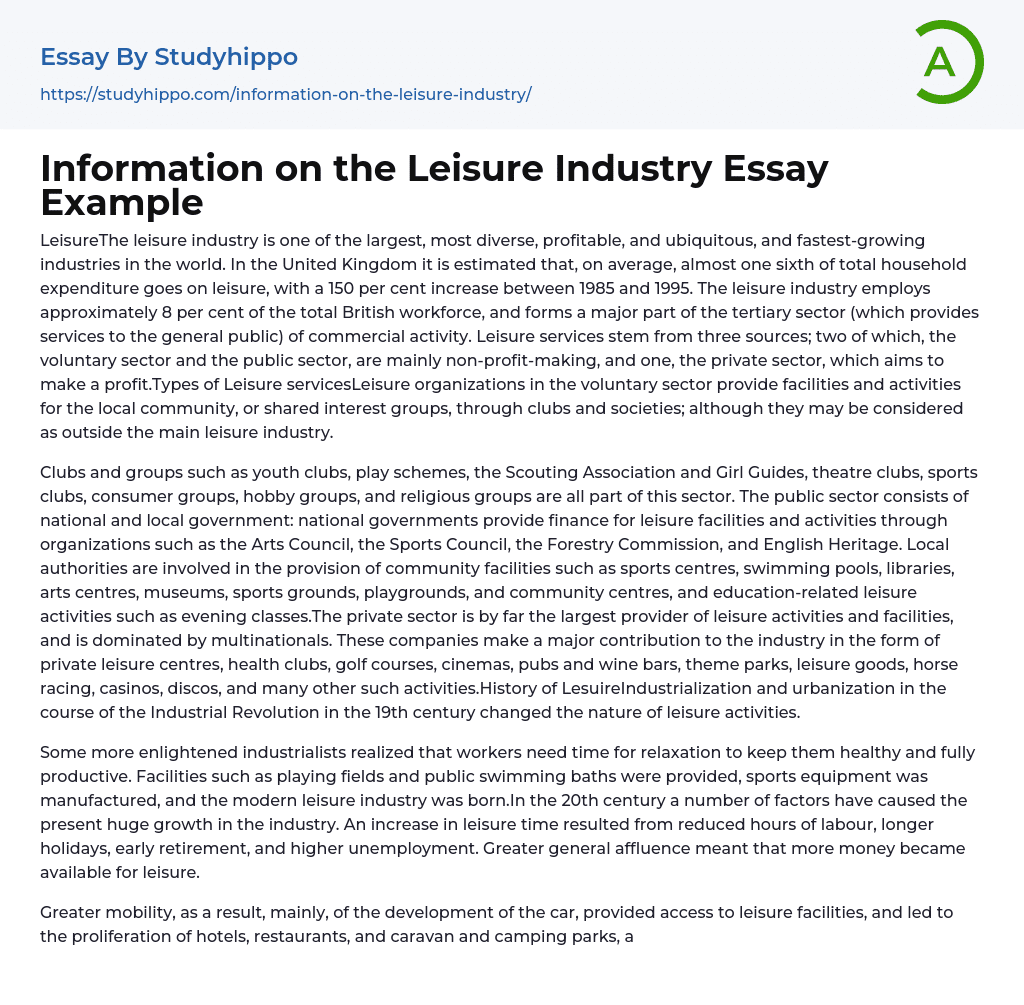LeisureThe leisure industry is one of the largest, most diverse, profitable, and ubiquitous, and fastest-growing industries in the world. In the United Kingdom it is estimated that, on average, almost one sixth of total household expenditure goes on leisure, with a 150 per cent increase between 1985 and 1995. The leisure industry employs approximately 8 per cent of the total British workforce, and forms a major part of the tertiary sector (which provides services to the general public) of commercial activity. Leisure services stem from three sources; two of which, the voluntary sector and the public sector, are mainly non-profit-making, and one, the private sector, which aims to make a profit.Types of Leisure servicesLeisure organizations in the voluntary sector provide facilities and activities for the local community, or shared interest groups, through clubs and societies; although they may be considered as outside the
...main leisure industry.
Clubs and groups such as youth clubs, play schemes, the Scouting Association and Girl Guides, theatre clubs, sports clubs, consumer groups, hobby groups, and religious groups are all part of this sector. The public sector consists of national and local government: national governments provide finance for leisure facilities and activities through organizations such as the Arts Council, the Sports Council, the Forestry Commission, and English Heritage. Local authorities are involved in the provision of community facilities such as sports centres, swimming pools, libraries, arts centres, museums, sports grounds, playgrounds, and community centres, and education-related leisure activities such as evening classes.The private sector is by far the largest provider of leisure activities and facilities, and is dominated by multinationals. These companies make a major contribution to the industry in the
form of private leisure centres, health clubs, golf courses, cinemas, pubs and wine bars, theme parks, leisure goods, horse racing, casinos, discos, and many other such activities.History of LesuireIndustrialization and urbanization in the course of the Industrial Revolution in the 19th century changed the nature of leisure activities.
Some more enlightened industrialists realized that workers need time for relaxation to keep them healthy and fully productive. Facilities such as playing fields and public swimming baths were provided, sports equipment was manufactured, and the modern leisure industry was born.In the 20th century a number of factors have caused the present huge growth in the industry. An increase in leisure time resulted from reduced hours of labour, longer holidays, early retirement, and higher unemployment. Greater general affluence meant that more money became available for leisure.
Greater mobility, as a result, mainly, of the development of the car, provided access to leisure facilities, and led to the proliferation of hotels, restaurants, and caravan and camping parks, as well as themed attractions. The interest in healthier lifestyles has, in recent years, resulted in demand for gymnasium and fitness facilities. Spectator sports are increasingly attracting a large number of people particularly as a result of being televised.The Future of LeisureThe amount of time and money available for leisure has never been greater than today, and the trend is forecast to continue. In particular, social entertainment in the form of cinema, spectator sport, visiting pubs, going out for a meal, dancing, along with home-based activities, including video, computers, and television are all viewed as areas set for major increases in public interest and expenditure. There are likely to be more new
mixed leisure concepts providing varied and extensive combinations of activities in a single complex, such as indoor tennis, golf driving ranges, shopping malls, entertainment centres, bars, restaurants, and exhibition and conference centres, all under the same roof.
- Movies essays
- Music essays
- Celebrity essays
- Television essays
- Actors essays
- Roller coaster essays
- Magic essays
- Media essays
- Video Game essays
- Wall Street essays
- Dead Poets Society essays
- A beautiful mind essays
- Sherlock Holmes essays
- Our day out essays
- American Beauty essays
- Do The Right Thing essays
- Forrest Gump essays
- Good Will Hunting essays
- Finding Forrester essays
- Looking For Alibrandi essays
- On The Waterfront essays
- One Flew Over The Cuckoo'S Nest essays
- Rabbit Proof Fence essays
- Remember The Titans essays
- Schindler'S List essays
- Shawshank Redemption essays
- The Blind Side essays
- Titanic essays
- Witness essays
- The Veil essays
- Blade Runner essays
- Monster essays
- The Graduate essays
- Twilight essays
- West Side Story essays
- Like Water For Chocolate essays
- Glory essays
- Superman essays
- Moulin rouge essays
- American Films essays
- Cinema Of The United States essays
- English-Language Films essays
- Film Editing essays
- Film Noir essays
- Film Techniques essays
- Horror essays
- Bollywood essays
- The time essays
- Saving private ryan essays
- The hunger games essays




